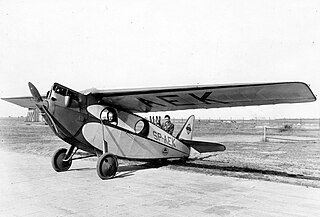
The RWD 4 was a Polish sports plane of 1930, constructed by the RWD team.

The SZD-45 Ogar (Hound) is a T-tailed cantilever high-wing monoplane of wooden, aluminium and fibreglass construction designed and manufactured in Poland.

The de Havilland DH.53 Humming Bird is a British single-seat, single-engine, low-wing monoplane light aircraft first flown in the 1920s.
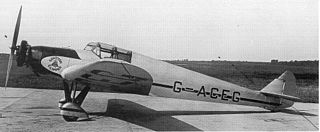
The Spartan Clipper was a British light touring aeroplane of the 1930s. It was a single-engine, two-seat, low-wing monoplane with a fixed tailwheel undercarriage.

The ANEC I and ANEC II were 1920s British single-engine ultralight aircraft designed and built by Air Navigation and Engineering Company Limited at Addlestone Surrey. One was privately constructed in Brisbane, Australia.

The Avro 560 was a British single-engined ultralight monoplane built by Avro at Hamble Aerodrome.

The Comper C.L.A.7 Swift is a British 1930s single-seat sporting aircraft produced by Comper Aircraft Company Ltd of Hooton Park, Cheshire.
The Bristol Type 91 Brownie was a light sports aircraft produced in the United Kingdom by the Bristol Aeroplane Company in 1924. It was a low-wing cantilever monoplane aircraft of conventional configuration with fixed tailskid undercarriage. The pilot and passenger sat in tandem open cockpits. It won the £1,000 pound prize for second place at the Lympne light aircraft trials in October 1924.

The Elliotts of Newbury EoN or Elliotts EoN A.P.4 was a 1940s British four-seat touring monoplane aircraft built by Elliotts of Newbury.

The Scheibe SF-25 Falke is a German touring motor glider developed from the earlier Bergfalke glider by Scheibe Flugzeugbau. Since May 2006 the business has been run by Scheibe Aircraft GmbH.
The Gnosspelius Gull was a 1920s British experimental ultra-light monoplane designed by Major O.T. Gnosspelius and built by Short Brothers at Rochester for the 1923 Lympne light aircraft trials.
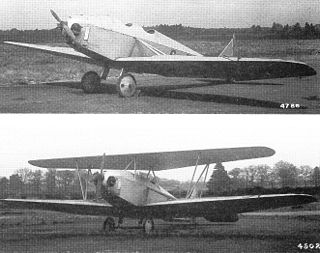
The Parnall Pixie was a low powered British single-seat monoplane light aircraft originally designed to compete in the Lympne, UK trials for motor-gliders in 1923, where it was flown successfully by Norman Macmillan. It had two sets of wings, one for cross-country flights and the other for speed; it later appeared as a biplane which could be converted into a monoplane.
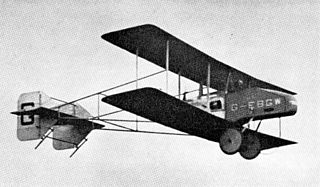
The RAE Zephyr was a single-seat, single-engined light pusher configuration biplane designed and built by the Aero Club of the Royal Aircraft Establishment (RAE) for the 1923 Lympne Motor Glider Competition. At a late stage the Aero Club chose to enter the more promising RAE Hurricane instead, using the Zephyr's engine, and the Zephyr itself was abandoned.

The Handasyde monoplane was a single-seat light aircraft built for the 1923 Lympne motor glider competition. It competed there but won no prizes.

The Auster 6A Tugmaster was a British high-wing monoplane glider tug converted from surplus former military Auster AOP.6s.
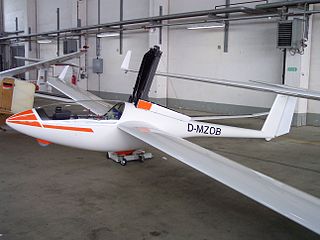
The Air Energy AE-1 Silent is a German self-launching ultralight sailplane powered by an electric motor. Designed and built by Air Energy, the AE-1 Silent is also marketed by Alisport of Italy, see Alisport Silent 2 Targa.
The Driggs-Johnson DJ-1 Bumblebee was a single engine, low power, single seat, parasol wing sports monoplane built in the US in 1924. It and its immediate development the Driggs Dart 1 had some competition successes; the design was further developed into two seat sesquiplanes known as the Driggs Dart 2 and Skylark. In all, about twenty were built.
The Silent Family Silent Glider M is a German ultralight trike motor glider, designed by Helmut Grossklaus and produced by Silent Family of Westerrade. The aircraft is supplied as a complete ready-to-fly-aircraft.
The Bonomi BS.19 Alca was a single seat, tractor configuration motor glider, designed and built in Italy shortly before World War II. It had an unusual retractable undercarriage used only for take-offs. Only one was built.
The Pegna-Bonmartini Rondine, or Pegna Rondine, is a single-seat ultralight sport aeroplane designed by Giovanni Pegna and built by Piaggio in Italy during 1923.
















